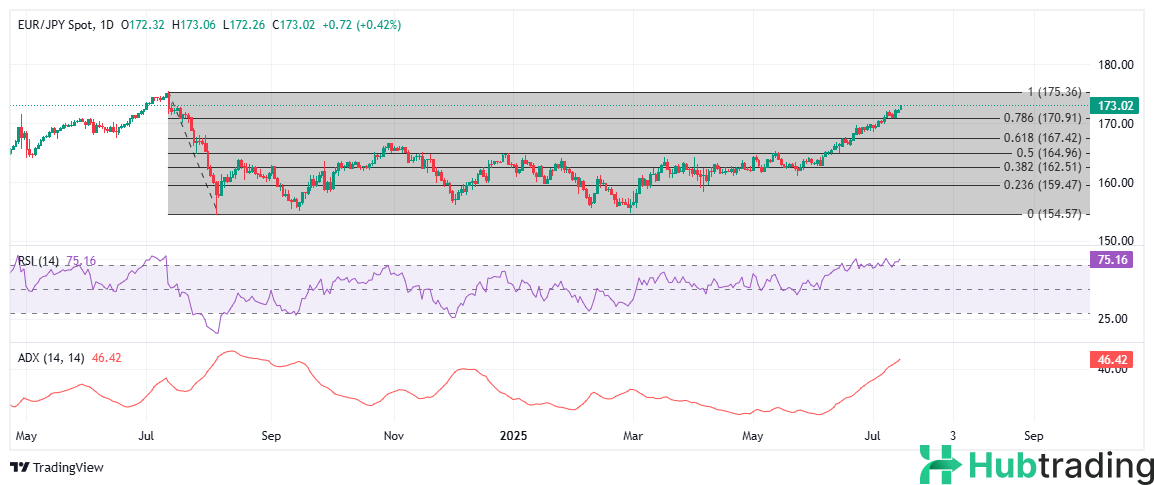-
EUR/JPY reaches a new yearly high, trading firmly above the 173.00 level during the U.S. session.
-
The Japanese Yen remains under pressure amid broad interest rate differentials, rising import-driven inflation, and growing political uncertainty.
-
Eurozone industrial production posts a strong recovery in May, increasing by 1.7% month-over-month and 3.7% year-over-year.
The Euro continued its upward trajectory against the Japanese Yen on Tuesday, marking a third straight session of gains as EUR/JPY surged toward the 173.00 level during the American trading hours — a level last seen on July 12, 2024. The rally is driven primarily by persistent Yen weakness, with the Japanese currency underperforming due to a stark interest rate differential, rising import-led inflation, and mounting geopolitical uncertainties.
Despite inflation remaining above the 2% target, the Bank of Japan (BoJ) remains reluctant to raise interest rates aggressively. Citing fragile domestic demand and external headwinds, policymakers have taken a cautious stance. Meanwhile, the political climate in Japan has added further strain on the Yen. With the July 20 Upper House elections looming, growing concerns that the ruling coalition may lose its majority have heightened investor anxiety over future fiscal policy direction.
This political uncertainty has constrained the BoJ’s flexibility, as the central bank avoids triggering volatility during a sensitive election period. Additionally, markets are beginning to price in the risk of post-election fiscal expansion, which could worsen Japan’s already elevated debt levels. These factors continue to weigh heavily on the Yen, enabling the EUR/JPY pair to hold near its highest levels in more than a year.
Supporting the Euro’s strength, fresh economic data from the Eurozone showed a solid recovery in industrial production. Output in May rose 1.7% month-over-month, reversing a 2.2% decline in April and beating expectations of a 0.9% increase. On an annual basis, industrial output climbed 3.7% — the strongest performance since early 2023 — signaling a rebound in manufacturing momentum.
Investor sentiment in the region also saw a slight improvement, with the ZEW Indicator of Economic Sentiment for July edging up to 36.1 from 35.3 in June. While the figure came in below the consensus forecast of 37.8, the upward movement reflects ongoing confidence in the Eurozone’s economic prospects.
Technical Outlook: EUR/JPY Maintains Bullish Momentum

From a technical standpoint, EUR/JPY remains in a strong uptrend, trading near the 173.00 mark. The pair has broken above key resistance levels, including the 78.6% Fibonacci retracement of the July–August 2024 correction at 170.91, which now serves as a key support zone.
The bullish structure on the daily chart is intact, with EUR/JPY consistently forming higher highs and higher lows. Momentum indicators support the upside move: the Average Directional Index (ADX) has climbed to 46.42, confirming strong trend strength, while the Relative Strength Index (RSI) is elevated at 75.16, suggesting overbought conditions that may trigger a short-term consolidation or pullback.
If bullish momentum continues, the next key upside target lies at the 100% Fibonacci projection near 175.36. However, with the RSI signaling overbought territory, a minor pullback cannot be ruled out. Immediate support rests around the 170.90–171.00 region, with stronger downside protection near the 167.50–168.00 area. As long as EUR/JPY remains above these support zones, the broader bullish trend remains intact, and any dips are likely to be viewed as buying opportunities.





